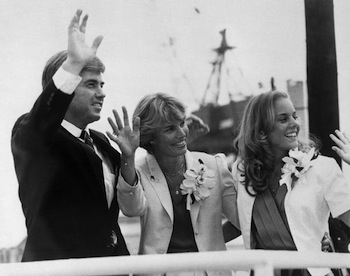Is Paul Ryan Jack Kemp, Model 2012?

Jack Kemp, his wife Joanne, and daughter Judith in 1980. Credit: NARA/Wikipedia.
“It all began with Buckley’s column.”
So declared Jack Kemp during the Republican National Convention in 1996. The Buckley in question -- William F. Buckley, Jr., founder of the National Review -- had dedicated a column to praising Kemp’s vision. “Here is a fresh view,” Buckley wrote, “filling the lungs with hope and excitement.” He then urged Bob Dole, the GOP nominee, to put the former quarterback on the ticket. Eight weeks later, Dole did just that.
Paul Ryan, Mitt Romney’s running mate, owes an even greater debt of gratitude to right-wing media. Kemp had one Buckley column to stir up support. In the week prior to Ryan’s selection, the tally soared far higher. Three pro-Ryan pieces on the Wall Street Journal editorial page. A lengthy endorsement at the Weekly Standard. Paeans in the National Review. (Rich Lowry, the magazine’s editor, tagged Ryan as “an ideologue in the best sense of the term.”)
The Ryan nomination follows the ascension of Sarah Palin in 2008, whose candidacy was willed into being by right-wing media personalities. So how did conservative media become, well, not kingmakers, but princemakers?
They’re indebted, in part, to the rising importance of political ideology. The two major parties were, for much of their history, held together less by shared ideology than strategic interests.
But in the late 1960s the GOP tacked right, purging moderates and liberals from the party. Within twenty years, Republican was synonymous with conservative. Conservative southerners fled to the new GOP, leaving the Democratic Party more ideologically consistent as well.
The Republicans’ increasing reliance on a right-wing base created an opening for conservative media. Not to hand-pick the top of the ticket -- there were and remain too many factors in play for one faction to control the outcome of the nomination. But when it came to the number-two spot, these media had far more influence.
First, Kemp. When Buckley endorsed him for the vice-presidency in 1996, he highlighted the former congressman’s two major selling points: his “comprehensive grasp of the economic scene” and his “ability to ignite enthusiasm” where Bob Dole failed. Putting him on the ticket would allow Dole to reframe the campaign around Kemp’s tax-cut plan.
Kemp also held the key to rallying conservatives. Dole’s attempts to energize the Right prior to the convention had failed badly. His inept pandering resulted in the Romneyesque declaration: “I’m willing to be another Ronald Reagan, if that’s what you want.” Kemp, on the other hand, was a true believer -- and, as the Buckley column demonstrated, the choice of leading conservatives.
The Kemp selection revealed conservative pundits had some sway. The real breakthrough for right-wing media, though, came in 2007. That summer, both the National Review and the Weekly Standard sent cruise ships stuffed with editors and writers to Alaska. There, the staff of both conservative journals met with Governor Sarah Palin.
Bill Kristol, editor of the Weekly Standard, was smitten. He returned from Juneau ready to sell Sarah Palin as the next big thing. He promoted her as “a genuine reformer” and, more personally, “my heartthrob.” Along with other Weekly Standard writers, he lobbied for Palin to be placed on the ticket with McCain.
McCain was forced to abandon his first choice, Democratic Senator Joseph Lieberman, when staffers warned of mutiny at the convention. Running out of time and in need of a candidate who would reinforce his maverick reformer message without alienating the base, he capitulated to the Palinites.
The message McCain hoped to sell, however, didn’t stick. What he and conservative media celebrated as maverick courage was viewed elsewhere as foolhardy recklessness. The base may have fallen in love with Palin, but the electorate did not.
Yet Republicans did not view the failure of the McCain-Palin ticket as an indictment of conservative media. They blamed liberal media bias, not ideology. In 2012, right-wing writers and radio talkers tried again, this time with a Tea Party hero well-protected from Palin-style indictments. A whip-smart policy wonk with thirteen years in national politics, Paul has been vetted from stem to stern. No surprises this time around.
Like Kemp and Palin, Paul Ryan slots neatly into his running mate’s central message. Chairman of the House Budget Committee, Ryan has the government counterpart to Romney’s private-sector experience. The Ryan budget hinges on sweeping entitlement reforms and makes the congressman appear serious about fiscal discipline. The ticket now presents a genuine alternative to President Obama’s economic policies.
At least, that’s the narrative Mitt Romney would like to take hold. There’s an equally compelling one the Democrats will push. They see the Romney-Ryan ticket as the sort of ruthless, soak-the-poor conservatism the Left has been warning about for years.
The Romney team has prepared for this attack. Introducing Ryan on Saturday, Romney flipped the script. “Unlike the current president who has cut Medicare funding by $700 billion,” he said, “we will preserve and protect Medicare and Social Security.”
But Romney may have overestimated how open the electorate is to the conservative media line on Ryan. Like Palin, Ryan has won the hearts of Bill Kristol, National Review, Glenn Beck, and the rest. Like McCain, Romney may find accepting their angle on Ryan was a major misstep.
